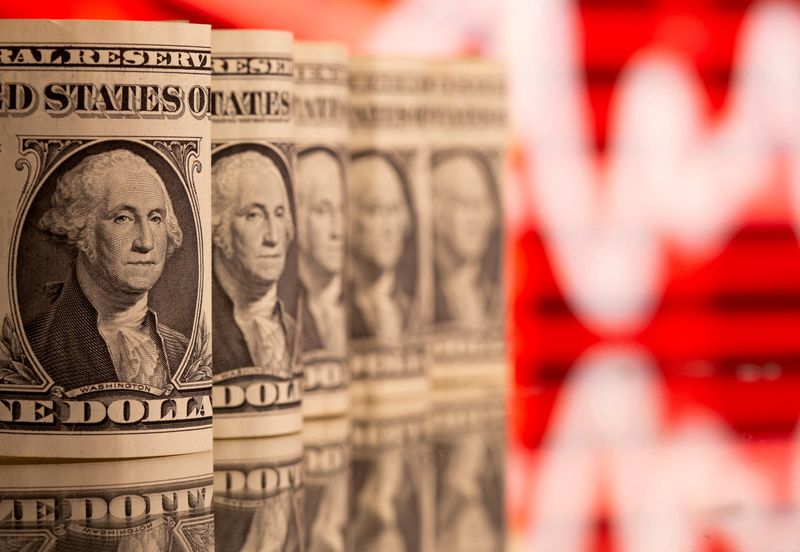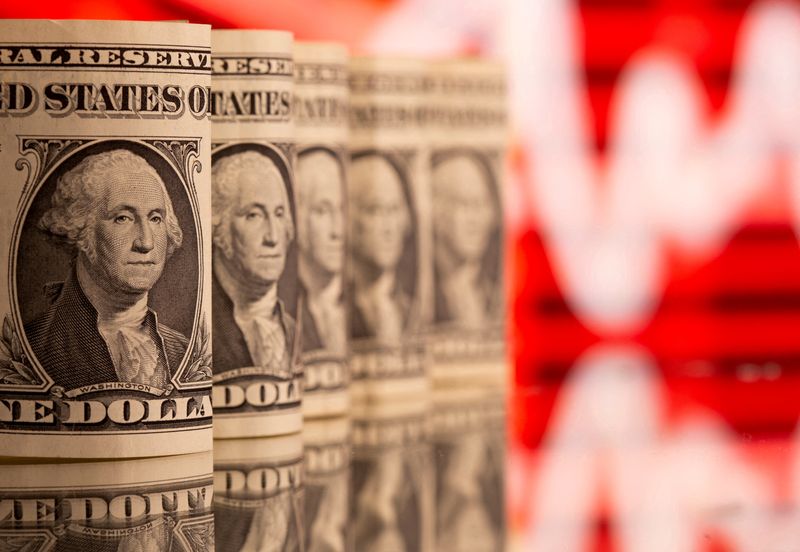Economy
Analysis-Bonds back in a tailspin as ‘higher for longer’ narrative hits


© Reuters. FILE PHOTO: U.S. One dollar banknotes are seen in front of displayed stock graph in this illustration taken, February 8, 2021. REUTERS/Dado Ruvic/Illustration/File Photo
By Yoruk Bahceli and Dhara Ranasinghe
(Reuters) -Government bond markets from Europe to the United States and Australia are in a tailspin as the prospect of higher interest rates sparks a rout in longer-dated bonds, hurting investors seeking higher returns after a lacklustre first half.
German and British two-year borrowing costs touched their highest levels since 2008 this week, U.S. peers hit highs not seen since 2007, and Australia’s bond yields rose to decade highs.
Crucially, while recent rises in borrowing costs had been driven by shorter-dated debt, longer-dated yields have led this week’s push higher, rising over 20 basis points (bps) in Germany, the United States and Britain.
The latest drubbing in the world’s biggest bond markets, which last year suffered a record rout, does not yet point to any dysfunction in the markets themselves, investors said.
But in echoes of the volatile conditions seen during March’s banking crisis, trading in euro zone benchmark German government bond futures were briefly interrupted on Thursday when bond yields spiked.
Investors took hawkish U.S. Federal Reserve June meeting minutes, strong U.S. services sector data and private payrolls numbers earlier this week as signs that the Fed — and other central banks — may have to keep rates higher for longer.
Weaker-than-expected U.S. non-farm payrolls data pushed two-year yields off their highs on Friday, but did little to soothe the selloff in longer-dated bonds.
“Markets are saying that inflation is too high, and growth is still too strong, and we need more rate hikes,” said Mike Riddell, senior portfolio manager at Allianz (ETR:) Global Investors.
“Central banks seem to be encouraging markets to believe this too, suggesting more hikes are ahead.”
Prospects for a November Fed hike had risen on Thursday in addition to a July move and traders reduced bets on cuts next year, though those moves reversed on Friday.
In Europe, traders bet the Bank of England would hike rates as high as 6.5% and briefly bet on a small probability that the European Central Bank will hike to 4.25%, from previous expectations for 4%.
HIGHER FOR LONGER
Germany’s 10-year yield, which staged its biggest daily jump since March on Thursday, was eyeing its biggest weekly jump since last September, up around 23 bps.
Bund futures on Thursday posted the biggest volume yet seen for the September contract, IFR analysts said.
U.S. and British 10-year yields were also set to end the week more than 20 bps higher.
That’s a sign that investors are reconsidering what “higher for longer” rates means for longer-term borrowing costs, said Nordea chief analyst Jan von Gerich.
As longer-dated borrowing costs rose faster than shorter ones, the closely watched U.S. yield curve measured by the gap between two- and 10-year Treasury yields was set to end the week steeper for the first time since early May.
It was at minus 88 bps, having flattened to minus 109.5 bps earlier this week in the biggest inversion since 1981.
“With long-dated bonds the issue is that yield curves have become so inverted it becomes hard to like long-term bonds unless you can convince yourself that rates will come down in your investment horizon,” said Mark Dowding, chief investment officer at BlueBay Asset Management, who holds a neutral position on U.S. and euro zone bonds.
In Germany, the 10-year yield rising above 2.5% marked a “significant development”, said Gael Fichan, head of fixed income at Syz Group, noting that was a level that had acted as resistance preventing higher yields in the shorter run.
Analysts noted 5% on two-year and 4% on 10-year Treasuries — levels breached on Thursday — as other key milestones.
“It is crucial to recognise that the repricing in the 7-10 year sector, where long positions are concentrated, is particularly susceptible to a stronger and sustained higher for longer narrative, potentially leading to losses,” Fichan said.
ING said earlier on Friday that this week’s data was strong enough to push yields higher even if jobs numbers interrupt the moves.
No doubt, the renewed selloff throws a curve ball at bond investors, who have been disappointed so far after last year’s record 13% losses.
The hope was for better returns in the second half of 2023, but global government bonds were down 1% this week through Thursday, cutting this year’s returns to a meagre 0.7%. Global equities, while down 1% this week, are still up 11% this year.
“There is a concern that if data remains strong, if central banks need to keep going further, then we are going to see a redux of 2022,” BlueBay’s Dowding said.
“It won’t be as bad as that, but higher rates and higher yields could lead to negative returns and pressure returns on equity markets.”
Economy
Russian central bank says it needs months to make sure CPI falling before rate cuts -RBC


© Reuters. Russian Central Bank Governor Elvira Nabiullina attends a news conference in Moscow, Russia June 14, 2019. REUTERS/Shamil Zhumatov/File Photo
MOSCOW (Reuters) – Russia’s central bank will need two to three months to make sure that inflation is steadily declining before taking any decision on interest rate cuts, the bank’s governor Elvira Nabiullina told RBC media on Sunday.
The central bank raised its key interest rate by 100 basis points to 16% earlier in December, hiking for the fifth consecutive meeting in response to stubborn inflation, and suggested that its tightening cycle was nearly over.
Nabiullina said it was not yet clear when exactly the regulator would start cutting rates, however.
“We really need to make sure that inflation is steadily decreasing, that these are not one-off factors that can affect the rate of price growth in a particular month,” she said.
Nabiullina said the bank was taking into account a wide range of indicators but primarily those that “characterize the stability of inflation”.
“This will take two or three months or more – it depends on how much the wide range of indicators that characterize sustainable inflation declines,” she said.
The bank will next convene to set its benchmark rate on Feb. 16.
The governor also said the bank should have started monetary policy tightening earlier than in July, when it embarked on the rate-hiking cycle.
Economy
China identifies second set of projects in $140 billion spending plan


© Reuters. FILE PHOTO: Workers walk past an under-construction area with completed office towers in the background, in Shenzhen’s Qianhai new district, Guangdong province, China August 25, 2023. REUTERS/David Kirton/File Photo
SHANGHAI (Reuters) – China’s top planning body said on Saturday it had identified a second batch of public investment projects, including flood control and disaster relief programmes, under a bond issuance and investment plan announced in October to boost the economy.
With the latest tranche, China has now earmarked more than 800 billion yuan of its 1 trillion yuan ($140 billion) in additional government bond issuance in the fourth quarter, as it focuses on fiscal steps to shore up the flagging economy.
The National Development and Reform Commission (NDRC) said in a statement on Saturday it had identified 9,600 projects with planned investment of more than 560 billion yuan.
China’s economy, the world’s second largest, is struggling to regain its footing post-COVID-19 as policymakers grapple with tepid consumer demand, weak exports, falling foreign investment and a deepening real estate crisis.
The 1 trillion yuan in additional bond issuance will widen China’s 2023 budget deficit ratio to around 3.8 percent from 3 percent, the state-run Xinhua news agency has said.
“Construction of the projects will improve China’s flood control system, emergency response mechanism and disaster relief capabilities, and better protect people’s lives and property, so it is very significant,” the NDRC said.
The agency said it will coordinate with other government bodies to make sure that funds are allocated speedily for investment and that high standards of quality are maintained in project construction.
($1 = 7.1315 renminbi)
Economy
Russian central bank says it needs months to make sure CPI falling before rate cuts -RBC


© Reuters. Russian Central Bank Governor Elvira Nabiullina attends a news conference in Moscow, Russia June 14, 2019. REUTERS/Shamil Zhumatov/File Photo
MOSCOW (Reuters) – Russia’s central bank will need two to three months to make sure that inflation is steadily declining before taking any decision on interest rate cuts, the bank’s governor Elvira Nabiullina told RBC media on Sunday.
The central bank raised its key interest rate by 100 basis points to 16% earlier in December, hiking for the fifth consecutive meeting in response to stubborn inflation, and suggested that its tightening cycle was nearly over.
Nabiullina said it was not yet clear when exactly the regulator would start cutting rates, however.
“We really need to make sure that inflation is steadily decreasing, that these are not one-off factors that can affect the rate of price growth in a particular month,” she said.
Nabiullina said the bank was taking into account a wide range of indicators but primarily those that “characterize the stability of inflation”.
“This will take two or three months or more – it depends on how much the wide range of indicators that characterize sustainable inflation declines,” she said.
The bank will next convene to set its benchmark rate on Feb. 16.
The governor also said the bank should have started monetary policy tightening earlier than in July, when it embarked on the rate-hiking cycle.

 Forex3 years ago
Forex3 years agoForex Today: the dollar is gaining strength amid gloomy sentiment at the start of the Fed’s week

 Forex3 years ago
Forex3 years agoUnbiased review of Pocket Option broker

 Forex3 years ago
Forex3 years agoDollar to pound sterling exchange rate today: Pound plummeted to its lowest since 1985

 Forex3 years ago
Forex3 years agoHow is the Australian dollar doing today?

 Cryptocurrency3 years ago
Cryptocurrency3 years agoWhat happened in the crypto market – current events today

 World3 years ago
World3 years agoWhy are modern video games an art form?

 Commodities3 years ago
Commodities3 years agoCopper continues to fall in price on expectations of lower demand in China

 Economy3 years ago
Economy3 years agoCrude oil tankers double in price due to EU anti-Russian sanctions





















